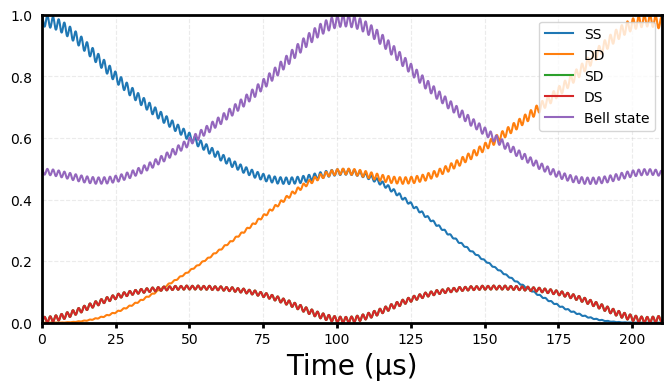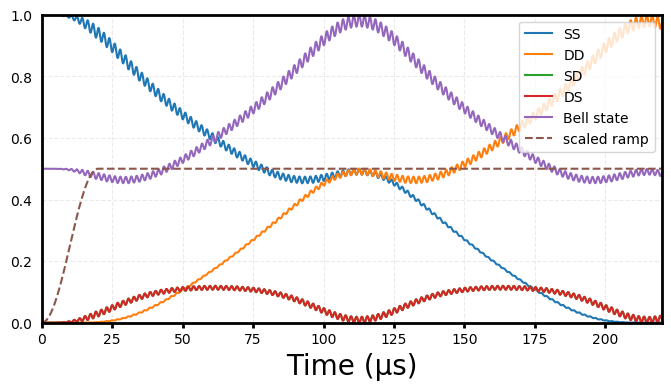Ramped Mølmer-Sørensen
Contents
Ramped Mølmer-Sørensen#
using QuantumOptics
using IonSim
import PyPlot
const plt = PyPlot;
# set some plot configs for the notebook
plt.matplotlib.rc("xtick", top=false)
plt.matplotlib.rc("ytick", right=false, left=false)
plt.matplotlib.rc("axes", labelsize=20, titlesize=20, grid=true)
plt.matplotlib.rc("axes", linewidth=2)
plt.matplotlib.rc("grid", alpha=0.25, linestyle="--")
plt.matplotlib.rc("font", family="Palatino", weight="medium")
plt.matplotlib.rc("figure", figsize=(8,4))
plt.matplotlib.rc("xtick.major", width=2)
plt.matplotlib.rc("ytick.major", width=2)
Consider two ions (modeled as two-level systems) and a single vibrational mode, addressed by bichromatic light in a rotating frame:
Variable definitions:
\(i\): Corresponding to the \(i^{th}\) laser.
\(\pmb{\Omega}\): Characterizes the strength of the ion-light interaction, which we assume to be identical for both lasers.
\(\pmb{\hat{\sigma_+}^{(j)}}\): If we model the electronic energy levels of each ion in order of increasing energy as \(|1⟩\), \(|2⟩\), then \(σ̂₊ = |2⟩⟨1|\) (the superscript \(j\) denotes the ion).
\(\pmb{\eta}\): Denotes the Lamb-Dicke factor, which characterizes the strength with which the laser interaction couples the ion’s motion to its electronic states.
\(\pmb{â}\): The Boson annihilation operator for the vibrational mode.
\(\pmb{\nu}\): The vibrational mode frequency.
\(\pmb{\Delta_i}\): The detuning of the \(i^{th}\) laser from the electronic energy splitting of the ion (assumed to be the same for both ions).
\(\pmb{\phi_i}\): The phase of the \(i^{th}\) laser.
Assuming \(\Delta_{1,2} = \pm (\nu + \epsilon)\), then, under the right conditions, this interaction can be used to produce a maximally entangled Bell state of the two ions.
Note
This interaction is the basis of the Mølmer-Sørensen gate, used by trapped-ion quantum computers.
However, in [Roo08] it is shown that a poor choice of the relative phase \(\Delta\phi = \phi_1 - \phi_2\) between the two lasers can impact the quality of this process by amplifying the effect of off-resonant carrier transitions.
Note
This effect disappears when \(\Delta\phi=0\) and is maximum when \(\Delta\phi=\pi\).
Fortunately, by ramping up the amplitudes of the lasers, we can eliminate this dependency on \(\Delta\phi\). In practice any smooth ramp that lasts a duration long relative to the period of the ion’s motion is sufficient.
In this notebook, we examine this effect, which will demonstrate how to construct time-dependent laser intensity in IonSim.
Bibliography#
- Roo08
Christian F Roos. Ion trap quantum gates with amplitude-modulated laser beams. New Journal of Physics, 10(1):013002, jan 2008. URL: https://doi.org/10.1088%2F1367-2630%2F10%2F1%2F013002, doi:10.1088/1367-2630/10/1/013002.



